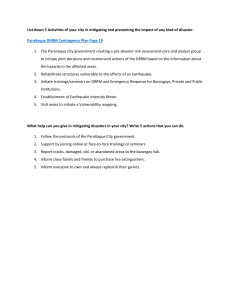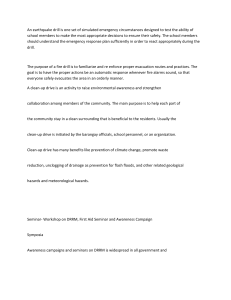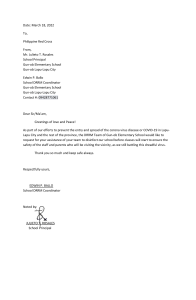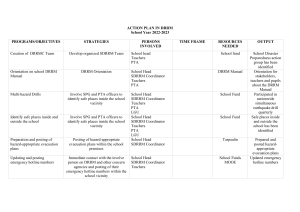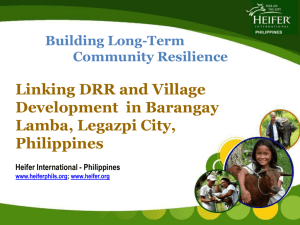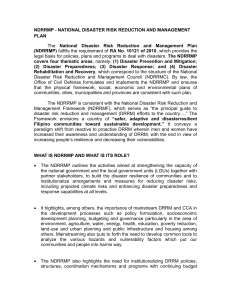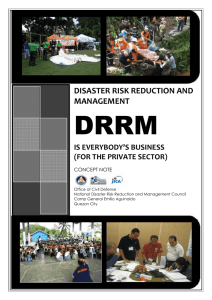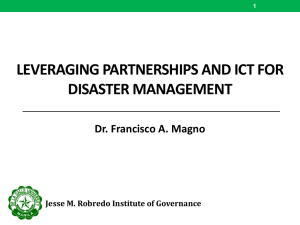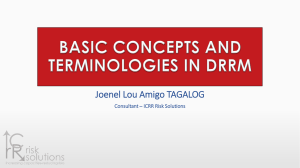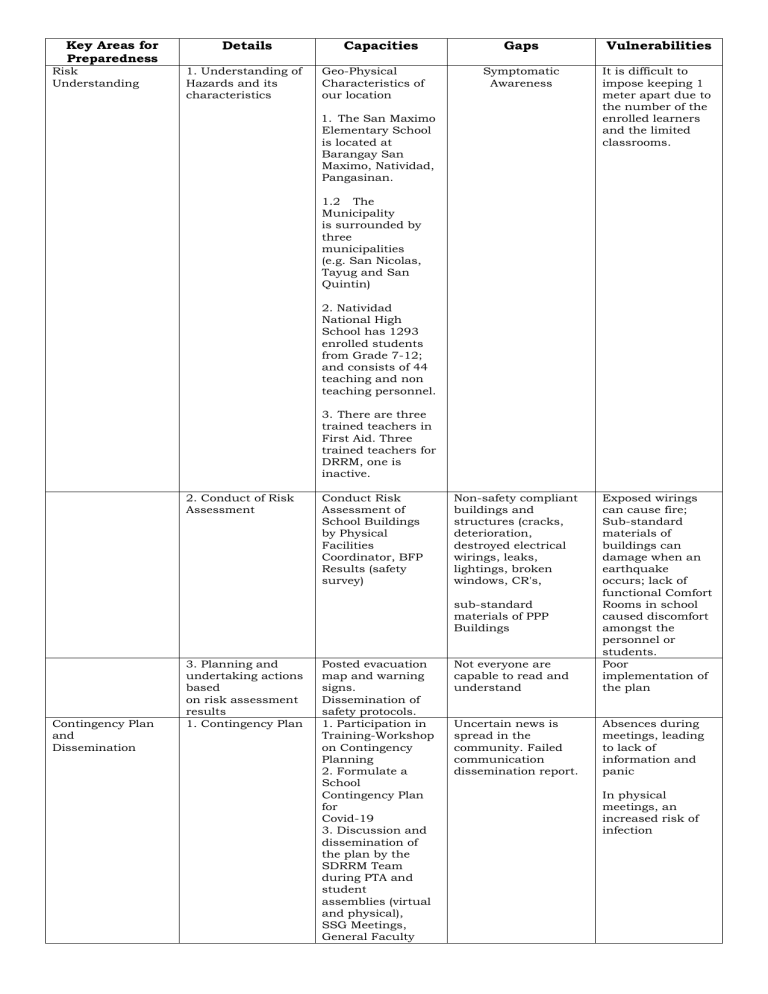
Key Areas for Preparedness Risk Understanding Details 1. Understanding of Hazards and its characteristics Capacities Geo-Physical Characteristics of our location Gaps Vulnerabilities Symptomatic Awareness It is difficult to impose keeping 1 meter apart due to the number of the enrolled learners and the limited classrooms. 1. The San Maximo Elementary School is located at Barangay San Maximo, Natividad, Pangasinan. 1.2 The Municipality is surrounded by three municipalities (e.g. San Nicolas, Tayug and San Quintin) 2. Natividad National High School has 1293 enrolled students from Grade 7-12; and consists of 44 teaching and non teaching personnel. 3. There are three trained teachers in First Aid. Three trained teachers for DRRM, one is inactive. 2. Conduct of Risk Assessment Conduct Risk Assessment of School Buildings by Physical Facilities Coordinator, BFP Results (safety survey) Non-safety compliant buildings and structures (cracks, deterioration, destroyed electrical wirings, leaks, lightings, broken windows, CR's, Not everyone are capable to read and understand Exposed wirings can cause fire; Sub-standard materials of buildings can damage when an earthquake occurs; lack of functional Comfort Rooms in school caused discomfort amongst the personnel or students. Poor implementation of the plan Uncertain news is spread in the community. Failed communication dissemination report. Absences during meetings, leading to lack of information and panic sub-standard materials of PPP Buildings Contingency Plan and Dissemination 3. Planning and undertaking actions based on risk assessment results 1. Contingency Plan Posted evacuation map and warning signs. Dissemination of safety protocols. 1. Participation in Training-Workshop on Contingency Planning 2. Formulate a School Contingency Plan for Covid-19 3. Discussion and dissemination of the plan by the SDRRM Team during PTA and student assemblies (virtual and physical), SSG Meetings, General Faculty In physical meetings, an increased risk of infection 2. IEC Communication 1. Understanding of advisory including warning signals 2. Understanding and implementation of DO 21 s.2015 3. Equipment Coordination 1. Division Office 2. P/M/CDRRMC 3. LGUs DepEd CO Meetings Posting/distribution of Posters, Flyers & Showing Videos on DRRM, Putting up of Signages, Installation of TV set in every classroom Early Warning System, Social Media, IEC, Billboards DRRM videos, Posting of Emergency Hotlines in every classroom & school offices, Joining group chats, use of social media, facebook page, etc. for submission of reports/needed data observing protocols (Disaster Risk Reduction and Management Coordination and Information Management Protocol) buzzer/alarm system, siren, cellphones, television set, computers, sound system Coordinate with the SDO2 Pangasinan DRRM Coordinator/PDO II, Sir Jodick Pulga., for DRRM updates and submission of data on enrolment & personnel Coordinate with the Pangasinan DRRM Coordinator, DRRM updates and activities, and asking for immediate rescue & response during disasters Coordinate with the Municipal Mayor & the MDRRMO Coordinator for DRRM updates and activities, suspension of classes. Saved number of hotlines Some students lack of interest Not all students will be given the flyers. Power Interruption, poor internet access/connection, Poor knowledge and understanding of some people so they may just ignore these early warnings Different interpretation on the implementation of DO 21 s. 2015 or not all are well oriented Some students may be left behind because not all can receive the message Inadequate communication equipments (megaphone, WalkieTalkie/2-way radio) Lack of equipment poor internet access during disasters Weak signal during the disaster busy hotline No or late response Late release of Advisories/Information Dissemination from LGU especially on Official Classes Suspension during disasters Late release of memos, announcements and advisories 4. Partners Monitoring Coordinate with the School PTA, BFP, PNP, Philippine Red Cross, Rural Health Unit & other agencies for related activities and needed assistance Observance of National Fire Prevention Month, National Disaster Consciousness Month, National Greening Day/ Frequent monitoring and updating of the management plan of the school related to DRRM Evaluation of the implemented plans, to update whenever possible Posters on Disaster Preparedness & Emergency Hotlines are posted in all classrooms, buildings, and offices for keeping communication line active Ocular inspection during and after the disaster/calamity for validation of damages in school for submission of RADaR report to our Division DRRM Coordinator conduct clean-up drive, psychosocial support, stress debriefing, makeup classes, provision of first aid/emergency kits, conduct ADM (alternative Delivery Mode for student victims Availability of Family Reunification form Lack of Manpower 6. Transportation School Van Service less accessibility of PUV's especially for affected areas 1. Interface among offices within the school Coordination & collaboration with the office of the Principal, Supply Officer, Physical Facilities lack of cooperation from other teachers 1. Monitoring of preparedness/contingency plan of school. 2. Monitoring of hazard situation, including communicating with school officials, district/division office and LGU 3. Monitoring RADaR completion, validation and submission to Central Office 4. Monitoring of implementation of support for learning continuity 5. Tracking of Learners and personnel CONVERGENCE Greater number of casualties during disaster poor internet connection/technical problem CP is not executed as planned Greater number of casualties during disaster Ignorance of the posted Emergency Hotlines (not saved on phone contacts/directory) Greater number of casualties during disaster through miscommunication poor internet access/connection during disasters uncooperative parents, student victims tend to lose hope Some parents don’t give their information to the adviser Contact numbers are not working / weak signal. 2. Existence of DRRM Team 3. Command System 4. Twinning with other divisions Support for Learning Continuity 1. Implement and monitor Temporary Learning Spaces (TLS) 2. Buffer stocks for learning materials 3. Alternative Delivery Modes 4. Psychosocial Support 5. Emergency School Feeding 6. Learner's Kits 7. Teacher's Kits 8. Hygiene kits Coordinator, Curriculum Grade Level Chairmen, PTA & SSG Officers, Regular Conduct of Meetings of the SDRRM Team Communication line is active from the principal down to the Department heads, grade level chairmen, teachers & SSG Officers Awareness on the use of alarm system/warning signal Coordinating with the PSDS in charge & the nearest school SMES Social Hall can be used as TLS Enough supply of books in the supply office, Functional School Library Modules are made available for homebound learners Guidance & Counseling sessions, Stress debriefing, Home Visitation The School Canteen Funds can be used for Emergency School Feeding Yearly Project-donation of school bags/supplies to less fortunate learners Provision of instructional materials to teachers such as cartolina, Manila paper and pentel pen by the school administration at the beginning of the school year Provision of sanitary napkins for menstruating women Other SDRRM Team Members are not cooperative Technical problem on the alarm system that sometimes it can't be heard from other buildings Lack of respondents The evacuation area can not accommodate the number of people. Outdated information Uncomfortable space for learning because it's hot during sunny days & it is an open space Some students don't have interest in using the learning materials No learning outputs Lack of moral support from parents Guardian does not come to school to get modules. Lack of gadgets or signal to send soft copies of modules. Lack of teachers who are trained in psychosocial support Inadequate Guidance Counselors The fund may not be enough for great number of locally displaced disaster victims Some students are choosy & they don't want to use the generic/unbranded materials Lack of information dissemination Psychosocial problems The school is not ready for the Emergency feeding program. Inadequate supply for the whole year The supply is for emergency purposes only and is not for 1:1 ratio Limited supply 9. Provision of Water Sanitation and Hygiene services NSED & Fire Drill, Tsunami Drill 10. Updated disaggregated data on learners and master list of students in school and alternative learning schools (ALS) Emergency Hotline, Evacuation & Vicinity Map/Plan/Route are posted in the Campus and in all classrooms & Offices. Functional Alarm System is existing Proper Orientation on the Conduct of the Drill to the students & the employees Communication Letters/SMS are sent to the PTA, PNP,BFP, MDRRMC & PDRRMC & messages through group chats of students & teachers for the conduct of the Drill Communication with other stakeholders 11. Clean up drives Support for Schools used as Evacuation Centers 12. Signed memorandum of agreement (MOA) with private enterprises for emergency purchase 1. Signed memorandum of agreement (MOA) between LGU and school on the use of schools as evacuation center including the roles and responsibilities of both institutions; 2. Repair, maintenance and replacement of schools identified as evacuation center by the LGU 3. Resumption Strategies including assessment of readiness of the schools The horizontal evacuation area for Earthquake and Floods as identified by the LDRRMO Malfunctioning of the alarm system (unexpected technical problem) Lack of cooperation from some of the students and the teachers Not everyone are cooperative Communicate with Municipal Mayor and other stakeholders for donations Loss of communication Communicate with Municipal Mayor and other stakeholders for donations SDRRM Teams readiness Loss of communication Lack of Training Lack of fund
